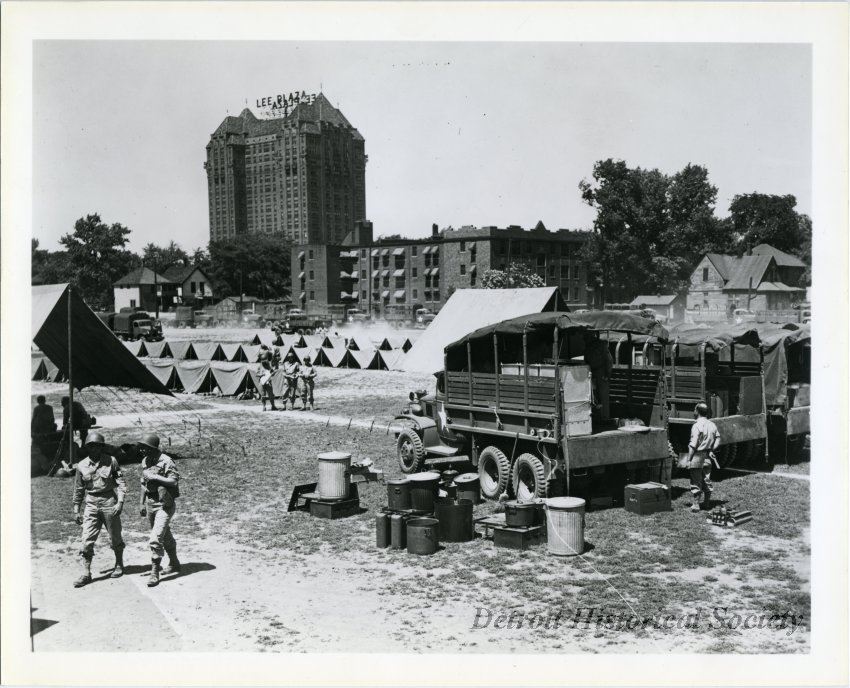Like the successive rebellion that would erupt 24 years later, the Detroit Race Riot of 1943 was deeply rooted in racism, poor living conditions and unequal access to goods and services. The apparent industrial prosperity that made Detroit the “Arsenal of Democracy” masked a deeper social unrest that erupted during the summer of 1943. Detroit was not alone in its turmoil that summer, though the violence and civil disturbances that occurred here were some of the worst in U.S. history.
Before and during World War II, workers migrated north to seek factory employment in such vast numbers that Detroit was incapable of adequately receiving them. Because Black Detroiters were still treated as second class citizens, they suffered disproportionately from wartime rationing and the overall strains on the city. Factories offered employment but not housing, and because Whites violently defended the borders of their segregated neighborhoods, Black residents had little choice but to suffer in repulsive living conditions.
Detroit’s 200,000 Black residents were marginalized into small, subdivided apartments that often housed multiple families, mostly in a few small sections of the city. One of these neighborhoods consisted of 60 square blocks on the city’s near east side, an area known as Paradise Valley and Black Bottom.
Because there was simply no space left to expand upon already existing African American neighborhoods, the city attempted to construct a Black housing project in what was otherwise a White neighborhood, though near the predominantly Black neighborhood of Conant Gardens. In 1942, a mob of more than one thousand Whites, some of whom were armed, lit a cross on fire and angrily picketed the arrival of their African American neighbors.
Black workers faced virulent racism on the job as well. In June of 1943, White workers halted production to protest the promotion of their African American co-workers. Other factories faced habitual slowdowns by bigoted Whites who refused to work alongside African Americans. Humiliation and resentment on each side spilled over into all facets of Detroiter’s wartime struggle and by the early 1940s, racially motivated street fights were common. The Ku Klux Klan was active in the region and riots had already broken out in other U.S. cities.
On June 20, 1943, as nearly 100,000 citizens packed Belle Isle, Black and White youths engaged in racially-motivated fighting on the island. Though police quelled the violence by midnight, tensions soared and later that night, two rumors led to incendiary action on both sides. African Americans at the Forest Social Club in Paradise Valley were told that Whites had thrown a Black woman and her baby off of the Belle Isle Bridge. As these rumors spread, rioting began around the Forest and Hastings Street area and moved north, with breaking windows, looting White businesses, and attacking White individuals.
In a nearby area, angry Whites had gathered after hearing that Black men had raped a white woman near the same bridge. Around 4 a.m., a mob of White men formed near the Roxy Theatre on Woodward. When the movie let out, Black men leaving the theatre were surrounded and beaten. Black motorists were also pelted with stones by White rioters. As word of both incidents spread, so did the violence.
White mobs overturned cars owned by Blacks and set them on fire and beat Black men as White policemen looked on. White doctor Joseph DeHoratiis was beaten to death while making a house call in Paradise Valley. African American community leaders pleaded for Mayor Edward J. Jeffries to call in help from national troops, which he did that morning, calling Michigan Governor Harry Kelly for assistance.
Violence was curbed by the arrival of over 3,500 troops in jeeps and armored personnel carriers, armed with automatic weapons. The streets became vacant around midnight, with most residents too terrified to leave their homes. Nine Whites and 25 African Americans were killed in the Riots of 1943. No White individuals were killed by police, whereas 17 African Americans died at the hands of police violence. 675 people were reportedly injured, with damages amounting to two million dollars.
A fact-finding committee created by Governor Kelly submitted a report, made public in August 1943, titled Factual Report of the Committee to Investigate the Riot Occurring In Detroit on June 21, 1943. This report largely ignored the social inequities that contributed to the event.

